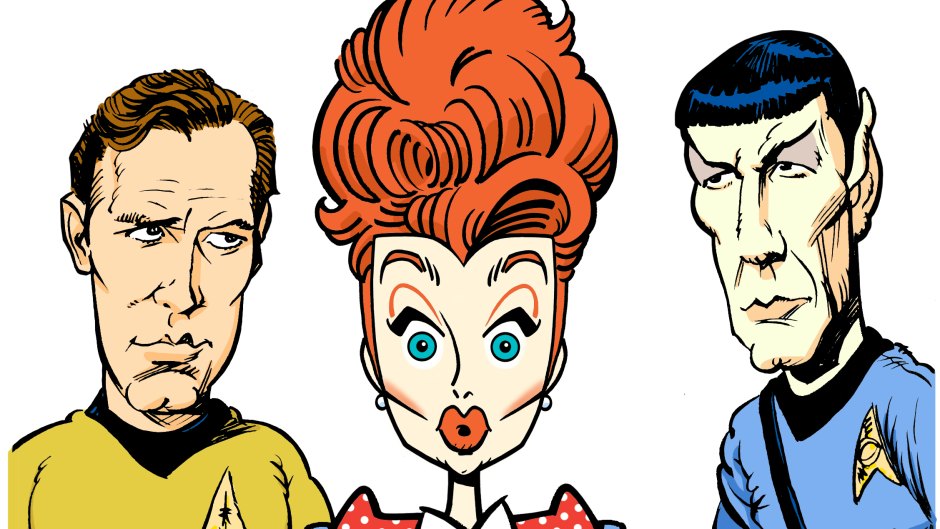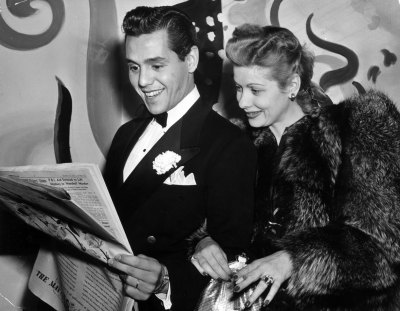
Tom Holtkamp
‘Star Trek’ Fans Should Really Love Lucille Ball — Without Her, It Wouldn’t Exist
You wouldn’t think Star Trek and I Love Lucy have anything in common, but there is a major, hidden connection between the beloved shows. In 1950, when Lucille Ball and Desi Arnaz were getting ready to launch their show, they formed Desilu Productions. Desi handled the business side of things, innovating a number of concepts that changed television, most notably shooting a TV show on film using three cameras, and filming in front of a live studio audience. The impact of those things cannot be measured. Lucy, on the other hand, focused more on creative issues, successfully choosing shows she felt would appeal to the audience and stand the test of time. Among those shows? Our Miss Brooks, The Lucy-Desi Comedy Hour, The Untouchables, The Lucy Show, Mission: Impossible, Mannix, and yes, Star Trek.

(Photo Credit: Getty Images)
And this is an important point to make — pay attention Trekkers out there — without Desilu and, specifically, Lucille Ball, Star Trek would not exist.
Author Marc Cushman, whose non-fiction book titles include the These Are the Voyages series, looking at the original Star Trek; as well as Long Distance Voyagers: The Story of the Moody Blues, comments, “Desilu came into existence because Lucille Ball and Desi Arnaz owned I Love Lucy. It was the first time someone owned the rerun rights to a show. For those rights they said they would cover the cost of shooting on film, and CBS agreed — no one had ever rerun anything before. Seems like a no-brainer today, but back then no one had done it.

(Photo Credit: Getty Images)
“Eventually,” he continues, “CBS bought the rerun rights back from Lucy and Desi for a million dollars, which was a lot of money back then. They take that money and buy RKO studios and turn it into Desilu Studios and everyone is coming to them asking them to film their sitcoms the same way they did their own. The company grows, but then the marriage falls apart and Lucy ends up running the studio. By this time they don’t have many shows. Lucy says, ‘We need to get more shows on the air,’ and Star Trek was one she took on, because she thought it was different.”
So did its creator, Gene Roddenberry. But he couldn’t convince anyone that his sci-fi adventure that took place on the galaxy-hopping starship Enterprise would work. “Desilu was the only studio that would take it,” he said, perhaps uncharitably adding, “The reason Desilu took it was because they had gone five years without selling a pilot and they were desperate. They said, ‘We’ll even try Roddenberry’s crazy idea.'”
Herbert F. Solow, executive in charge of production at Desilu, admits he was met with a lot of opposition regarding the series. “I had so many people at the studio, so many old-timers trying to talk me out of it,” he says. “‘You’re going to bankrupt us, you can’t do this. NBC doesn’t want us anyway, who cares about guys flying around in outer space?’ The optical effects guy said it was impossible to do. Everyone said there wasn’t enough time or money, and from the physical production point of view, we can’t attract the talent needed. If you don’t listen to that and stubbornly go into it, that’s the only way we could have got it done.”

(Photo Credit: Getty Images)
Marc points out that Lucy was trying to do things the way Desi had taught her. But he wasn’t there anymore. “He was drinking at that point; he was not leaving his house and was basically just burned out,” he explains. “So she is asking herself, ‘What would Desi do?’, because she really loved and respected him. ‘Desi would get more shows on the air that we own, not just that we’re producing for other companies.’ So that was her reasoning to do Star Trek — and she felt that this show could, if it caught on, rerun for years like I Love Lucy. And guess what? Those two shows — I Love Lucy and Star Trek —are two shows that have been rerunning ever since they originally aired. The problem was, her pockets weren’t deep enough.”
With NBC wanting to do business with Desilu, they agreed on a pilot for Star Trek, which Desilu would produce. The result was an episode called “The Cage” that had many elements that would become a staple of the Star Trek audiences would eventually encounter — including Leonard Nimoy as Mr. Spock. But there was no William Shatner; sitting in the captain’s chair was Jeffrey Hunter (who would go on to play Jesus in King of Kings) as Christopher Pike. In the end, NBC rejected the pilot, but were intrigued enough to request a second.

(Photo Credit: Getty Images)
“Getting a second pilot was enormously rare,” says Herbert. “If a pilot didn’t work the first time, the networks said, ‘Oh, forget it; it’s over.’ Television is unlike any other business in that way. But we got the second pilot.”
And that one, with William Shatner as Captain James T. Kirk, got the green light to go to series; a series from which five TV spin-offs and 13 feature films would eventually spawn. Yet for all of that (and the same was true of Mission: Impossible, which debuted the same year as Trek), in its original run, it was operating on a deficit, the belief being that the true money would come from reruns.

(Photo Credit: Tom Holtkamp)
The big problem in that regard for Star Trek was that the show wasn’t doing that great, and was more or less being canceled by NBC at the end of the second season. The only thing that saved it was a massive letter-writing campaign that generated a reported one million letters to the network and resulted in the show being renewed for a third and final year. That last year, it should be pointed out, gave them just enough episodes so that it could go into reruns in America. But for Lucille Ball and Desilu, it turned out to be too little, too late. With no choice, Lucy sold Desilu to Paramount, which in one fell swoop acquired ownership of everything (except I Love Lucy), including, of course, Star Trek. Not that Paramount was doing corporate back-flips over that failing sci-fi TV show.
As Marc explains it, Paramount took over at the halfway point of Star Trek‘s second season and immediately started tightening the budget, the attitude being that the production wouldn’t do to them what it had done to Desilu. “Lucille Ball lost her company because of Star Trek,” he says. “She had gambled on the show and you can read the memos where her board of directors is saying ‘Don’t do the show, it’s going to kill us.’ But she believed in it and moved forward, and it cost her her studio.”

(Photo Credit: Getty Images)
Veteran television director Ralph Senensky, who directed a number of episodes of Star Trek, comments, “Desilu was like a family. Herb Solow, who was the head of the studio, used to come down and talk with you on the soundstage. He didn’t seem like the other studio heads who never seemed to talk to you. Herb went out of his way to help you. Can you imagine a studio working like that? When Paramount bought it, a kind of corporate mentality took over. In a way, I think that’s why I resent Paramount having such a hit in Star Trek, because if they had their way, they would have killed it off. It survived in spite of them, and now they have this bonanza making them all of this money.”
“Lucy’s instincts about Star Trek were right,” Marc adds, “but they were losing $15,000 an episode, which would be like $500,000 per episode today. The board was saying, ‘We’re not a big studio,’ and she would say, ‘Somehow it’s going to work out.’ You know, if she could have hung on just six months longer, it would have worked out, because by the end of the second season, once they had enough episodes, Star Trek was playing in, I believe, 60 different countries around the world. And all of that money is flowing in. It’s just that she couldn’t last those extra six months.”

(Photo Credit: Getty Images)
She was, he says, several million dollars shy of being able to hang on, and in those days bank loans weren’t as available as they are today. And credit cards weren’t a viable option either, leaving her with little choice.
“Lucy actually took off and went to Miami,” Marc details. “She ran away, because it was so heartbreaking to sign the contract. They had to track her down to get her to do it. There’s a picture of her cutting the ribbon after they’ve torn down the wall between Paramount and Desilu, and she’s standing next to the CEO of Gulf and Western, which owned both studios now, and her frozen expression is she’s trying to put on a brave face for the photographers, and trying to fake this smile for the camera. And you know it’s just killing her. But, again, she was right. One hundred percent. The two most rerun shows in the history of TV are I Love Lucy and Star Trek.”
For much more on this and Star Trek, check out The Fifty-Year Mission: The Complete, Uncensored, Unauthorized Oral History of Star Trek by the author of this article and Mark A. Atman.








































